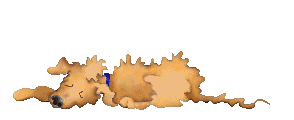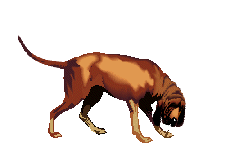 Canine
pregnancy is an exciting experience. Ease your dog into
delivery with these simple steps, and help prevent any complications
that may arise.
Canine
pregnancy is an exciting experience. Ease your dog into
delivery with these simple steps, and help prevent any complications
that may arise.
Helping to bring newborn puppies into the world can be a
thrilling experience. Unfortunately, your dog can't always
tell you when things aren't going as smoothly as planned.
While it's your dog that will still do most of the work,
there are some simple measures you can take to ensure that
all goes smoothly during labor and delivery and there are
no major complications.

The
Basics about Doggie Pregnancy

Dogs generally give birth 58-68 days
after conception. It's always a good idea to have a veterinarian
check over your pup during pregnancy, just to be sure she's
eating enough, getting all the nutrients her growing body
requires, and there are no obvious complications. You'll know
your dog is nearing the birthing time when her appetite increases
and her need for playtime and attention decreases. During
this time, she may begin hiding in various areas of the house,
trying to nest.

 The
Making of a Maternity Ward
The
Making of a Maternity Ward
Most dogs will decide
on their own where they're most comfortable giving birth.
Pets seem to favor enclosed areas that are void of noise,
distraction and foot traffic. Favorites include closets,
stairwells, and behind objects. If this is conducive to
your lifestyle, by all means, let her go where she's comfortable.
If not, it's okay to set up a Maternity Ward of your own.
A kiddie sized swimming pool makes an excellent birthing
space. The pool will be easy to clean and will also prevent
the newborn pups from tipping out. Line the kiddie pool
with old sheets or fresh towels and newspapers that you
can quickly throw away and or replace during labor and delivery.
Boxes also make excellent spaces for giving birth. Experts
use what's called a "welping box," which is nothing
more than a box in which the dog will have adequate privacy.
You can make your
own box at home with a cardboard oven or refrigerator box.
The box you use should be large enough for mom to stretch
out and still leave enough space for small pups. One side
should be low enough for the mother to crawl in and out
of, but high enough to prevent the puppies from doing so.
Whatever you decide to use, try to acquaint your pet with
her maternity ward early so she'll be more likely to feel
comfortable there when the time comes.

Make
Her Comfortable

Line your box or pool
with as many towels or sheets that you can find. Remember,
your dog has a long night ahead of her. Tossing in her favorite
toy or blanket will encourage your pet to use her whelping
box. Making your dog comfortable during this time should
be your top priority.


Keep
the Noise Down
Your pet will want
some privacy on the big day. Loud noises, company and constant
interruptions will only make your dog nervous. As much as
small children (and even adults) would like to experience
the delivery, try and keep human contact to a minimum.


Is
it Time?
Approximately 6-24
hours before giving birth, your dog may begin shivering,
pacing, panting or acting out of character. She may trot
around nervously or claw at the floor, looking for a place
to nest. If your animal does begin to nest elsewhere and
refuses to use her whelping box, let her go. Provide fresh
bedding and newspapers where she is and move the whelping
box close to her. As the puppies are born, you can move
them into the box, which will encourage mom to follow.

During
Emergencies:

Most births
go smoothly. There are occassions, however, during which
the mother may need help. Watch for these danger signs and
act immediately, if necessary:
1. Your dog
passes dark green fluid before delivery.
2. Your dog
has been straining (without delivering) for more than one
hour.
3. Your dog
is weak, restless and nervous for more than thirty minutes
after labor stops.
4. Your dog
begins shaking, trembling or begins vomiting days or weeks
after delivery. Should your pet exhibit any of these symptoms,
contact your veterinarian immediately.
These are
emergency symptoms and time is of the essence.


The
Birth

Dogs generally
take care of themselves during birthing and delivery, and
there is rarely a cause for human intervention. There are
a few instances however, when you may need to act as midwife
for your friend. Follow these guidelines for a safe delivery:
1. If a puppy
seems to only come out half way, despite extensive straining
by it's mother, you'll need to jump in and assist. Have
someone hold your pet's head and gently grab the puppy with
a clean towel and pull firmly. If the puppy doesn't immediately
slide out, call your veterinarian immediately. 
2. The mother
will get more and more tired during large litters. Though
dogs instinctively tear off the amniotic sac and bite the
umbilical cord off, your dog may be too weak or tired by
the end of delivery to do so. If you find that a puppy has
not been cared for after delivery, remove the amniotic sac
by peeling it from the puppy. Start at the baby's mouth
and work toward it's tail. You can clean the mucus from
it's mouth with your finger. Also, be sure to vigorously
rub the puppy for several seconds with a clean towel. This
will keep the puppy's heart beating and help to integrate
him in the outside world. If need be, you can cut the umbilical
cord yourself with a sterile scissor or tie it off with
sewing thread.

Things
You'll Need:
Lots of clean blankets
Lots of clean towels
Puppy formula (Esbilac)
Baby bottles with small nipples
Newspaper
Betadine for umbilical cords
Sharp scissors and alcohol for cutting umbilical cords
Unwaxed dental floss for umbilical cords (may or may not
be needed but best to have on hand)
A heat lamp
Most importantly - your vet's emergency phone number
If your female was
bred on March 23rd, her due date would be approximately
63 days later BUT some bitches can whelp as early as 58
days and as long as 66 days. Your female is far enough into
her pregnancy now that you can have her ultrasounded to
determine if indeed she is actually pregnant. It is VERY
important to see your vet now for a prenatal examination
and to discuss whether or not your dog will be able to have
these puppies naturally or require a c-section. Dachshunds
are one of the breeds that more often than not requires
a c-section for the safe delivery of the litter. If it is
determined that your dog is pregnant, she needs to be eating
a premium quality PUPPY food to meet the nutritional requirements
of the puppies. If it is determined by your vet that you
will attempt to allow your dog to have these puppies naturally,
starting on about day 56, you do not want to leave her alone
for any period of time. You need to monitor her very closely
for any signs of trouble. When she is ready to start labor,
she will most likely appear to be restless and uncomfortable.
Some females will begin panting during pre labor while others
will not pant until the actual labor begins. You should
be monitoring her temperature every couple of hours and
when it drops below 100 degrees, labor normally starts 12
to 24 hours there after. This is not always accurate but
can be used as a tool to help determine when the puppies
will arrive. You must work very closely with your vet and
be sure he/she is available should you run into any problems.
If your female is contracting and straining with no production
of a puppy within an hour, you need to call your vet immediately.
I could literally write pages and pages of information on
the birthing of puppies and the precautions but this is
something you really need to do on your own. You need to
start searching the web and reading as many books as you
can find on breeding dogs. This is all information that
should have been researched PRIOR to breeding your female.
Breeding is not something to be taken lightly and maybe
you don't even realize that you have put your female at
risk for some serious problems. Please make an appointment
with your vet asap for a prenatal examination and to discuss
the proper care of your female to keep her in the best health
possible. I also strongly urge you to have your female spayed
when she is done weaning this litter. With all due respect,
you are neither equipped or knowedgeable enough to be breeding
dogs. Please do as much reading as you can between now and
the end of May when the puppies will arrive. If you have
anymore questions, please let us know.

The
Aftermath

Now that
your dog has given birth, you have a whole new family to
watch over. Remember, your dog will be protective of her
new pups, so for at least the first few hours, keep traffic
to a minimum. Your dog may also not want to leave her whelping
box after birth. Let her actions guide your behavior, but
also make sure she has an adequate supply of water and food
and is allowed outdoors to relieve herself whenever needed.
It's helpful to place the dog's food and water close to
the whelping box, so she feels comfortable enough to care
for herself. And that's it. Now it's time to enjoy all the
new, noisy life in your house!


False
Pregnancy In The Dog

FALSE PREGNANCY
IN THE DOG occurs when the bitch produces both physical
and psychological changes that are a nuisance to the bitch
and the owner. The psychological changes in the owner arise
most often when informed that their prize bitch is NOT pregnant
after all! The bitch will often produce milk, engage in
nesting activity and look like she's pregnant. It's amusingly
sad to see the affected dog try to persuade a tennis shoe
to nurse! These visible changes take place beginning about
4 weeks after the heat cycle begins (estrus) and can continue
for a number of weeks. False pregnancies are always unpredictable
and can show up whether or not a mating has occurred. Often
so much milk is produced the bitch becomes uncomfortable.
Once a dog has had a false pregnancy she's likely to be
afflicted again.

Appearance
Most dogs
experiencing a false pregnancy will begin to show some swelling
in the mammary glands about five weeks after their heat
cycle has ended. If you have bred your bitch, you will be
elated that she "is getting ready to have pups".
You might also be surprised that she "isn't filling
out much". You will wonder why she isn't starting to
show a big belly. Many dogs whether they are bred or not,
will develop a false pregnancy, and look, act, and even
think as if they are pregnant. Some will carry small toys
or pillows around and even start digging a nesting site
wherever they please. When the time draws near to when they
would be delivering the pups, usually 63 days after a mating,
milk will drain on its own from the mammary glands. Some
dogs are really troubled that they cannot find the pups
they psychologically feel they should be nursing.

Cause Of
False Pregnancy In Dogs
The exact hormonal
mechanisms that must occur to trigger false pregnancy are
as yet unknown. We do know that a combination of interacting
hormones including estrogen, adrenal hormones, and prolactin
from the pituitary gland influence milk production in the
mammary glands. Prolactin levels seem to be the main culprit,
but why this hormone does what it does when it shouldn't
is a subject for future research.
Fortunately 90% of false pregnancies resolve over a period
of three weeks with no treatment. Since no real harm is
done there's no reason to speed up what nature will take
care of in time. For about 10% of bitches, though, the psychological
effects directing mothering behavior are so intense that
the bitch is miserable. She's continually searching for
pups that aren't there and seeking relief from the mammary
gland engorgement that's making her uncomfortable. Mastitis,
an infection of the mammary glands, if it were to occur
at this time could be particularly dangerous.
On occasion, in about 10% of false pregnancy cases, treatment
is warranted. Various hormonal substances have been used
to hasten the reabsorption of milk and to halt the milk
production. None of these medications is entirely safe so
close veterinary supervision is necessary. Most often the
veterinarian will administer a hormone to interrupt the
dog's secretions of internal hormones that may be promoting
the production of more milk.

Breeding
Soundness
Any bitch showing
false pregnancy is apt to have a reoccurrence in the future.
There is NO reason NOT to breed this bitch but she may be
a poor producer. There seems to be a greater risk of pyometra,
a severe infection of the uterus, in any female dog that
has had false pregnancies. Learn more about Pyometra in
the Surgery Room. There's no way of predicting the outcome
of any breeding but many bitches that have had a false pregnancy
have gone on to whelp normal, healthy litters. Evidence
does not indicate that false pregnancies are an inherited
disorder.


